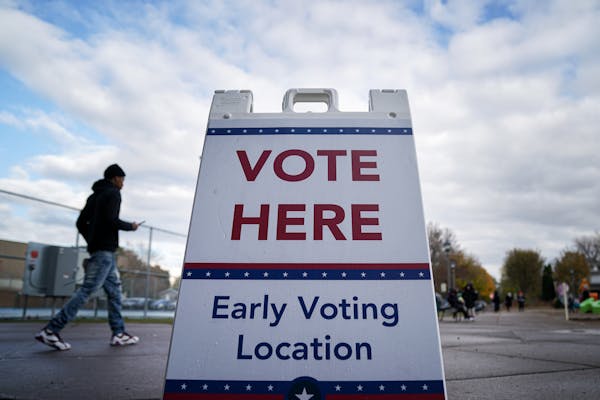Southwest Minneapolis college student Grace Murray had always followed current events, but she became passionate about Democratic politics after the 2016 election that put Donald Trump in the White House.
On the other side of the political divide, University of Minnesota Duluth senior Tiffani Skroch is seeing a lot of excitement about reelecting Trump.
Predictions of youth voting have often fallen short in the past, but new data emerging before the 2020 election suggests that young people like Murray and Skroch could have an outsized impact in state and national politics, particularly in Minnesota, where rates of youth voting are consistently higher than in other states.
Murray, a 20-year-old Tufts University junior, has stayed active since founding her school's chapter of the High School Democrats of America, which fosters youth activism on the left. "I feel that my exposure with grassroots organizations has really just solidified my belief in the power of the youth vote and all the voices that have been historically underrepresented in this country," Murray said.
Skroch, president of the UMD Bulldog Republicans, has been organizing literature drops for the 2020 elections with other club members in the Duluth area.
"This new generation is so active and so interested in knowing what's going on in the world. Everyone is starting to realize how important it is to vote and how much it really affects you," Skroch said. "With the pandemic I think that people are sitting at home watching the news more and realizing actually how much is happening and how much the government affects their daily lives."
A recent nonpartisan Center for Information and Research on Civic Learning & Engagement (CIRCLE) survey of voters between ages 18 and 29 revealed that both youth activism and political engagement are on the rise.
It found that 83% of those polled said they believe they have the power to change the country. Nearly 80% said the COVID-19 pandemic has helped them realize the effect politics has on their lives — during a time when campaigns are pursuing varied avenues to connect with their demographic.
Another CIRCLE poll ranks Minnesota ninth in the top states where young people have the power to swing the election, a key data point for a battleground state that Democrat Hillary Clinton won by just 44,000 votes in 2016.
During the last presidential election, more than 460,000 young people in Minnesota voted, said CIRCLE director of impact Abby Kiesa.
Exit polls from 2016 showed that Clinton carried 45% of the youth vote in the state, compared with 42% for Trump; another 13% voted for other candidates.
That means that almost 210,000 young voters helped carry the state for Clinton, said Kiesa. "That is a huge contribution to keep the election competitive," she said.
Youth turnout numbers from the midterm elections are another key indicator of engagement in 2020, she said.
"The youth turnout in 2018 in Minnesota actually came close to the 2016 turnout. Something happened in 2018 that really mobilized a lot of young people. While it was a midterm, the fact that so many young people may have already been registered to vote before we got into 2020 means they're more likely to cast a ballot in 2020," Kiesa said.
Still, reaching young Minnesotans during the COVID-19 pandemic has been a challenge. With colleges likely to remain shuttered in the fall, both the DFL and the GOP are embracing digital tools.
Murray is a participant in Blue Future, a 10-week program that trains young people in progressive campaign organizing. More than 120 students from several states are spending the summer working to elect Democrats to the Senate, including the re-election campaign of Minnesota U.S. Sen. Tina Smith.
While many young progressive activists are focusing on opposition to Trump, state GOP spokeswoman Preya Samsundar said the Republican Party has been able to engage young voters, specifically when it comes to economic issues.
"They are all too aware of the importance of having high-paying jobs, low unemployment rates and just having the opportunity to get their foot into the door," Samsundar said. As the state opens up, the Trump campaign is transitioning to in-person events but has also used Zoom, Google Hangouts and social media to connect with young voters.
With more people forced to stay home during the pandemic, it has been easier to connect with voters, said Minnesota DFL Chairman Ken Martin. Voters young and old are more likely to pick up the phone or attend an informational Zoom meeting. But Democrats feel like they have an edge with young, idealistic voters focused on issues like climate change and racial equity.
"We've been having a lot of great conversations on high school campuses around the state as well as college campuses, and in those professional spaces," Martin said. "We know that young voters are the key to this election."
Zoë Jackson covers young and new voters at the Star Tribune through the Report For America program, supported by the Minneapolis Foundation. 612-673-7112 • @zoemjack
Carolyn Parnell, 'trailblazer' who served as Minnesota's first IT commissioner, dies



